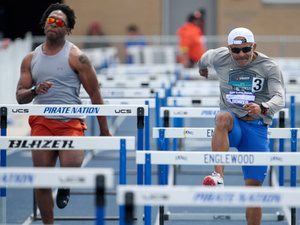I believe the common wisdom that track & field builds athletes. Every element of sprinter training contributes to athleticism, meaning more speed, power, strength, and coordination. While the most important part of a sprinter’s training is full-speed sprinting, there’s a lot of value to strength training in the weight room. So here’s how to lift with purpose for any athlete trying to get faster.
Principles Of Strength Training For Sprinters
Safety And Mobility Are Part Of Performance, Not Separate From It
Every athlete needs to make time to learn safe technique for each exercise in the weight room. Use a full range of motion in every exercise so you develop coordination across all the muscles spanning each active joint. Select exercises that address multiple planes of motion so you develop a balanced, resilient body.
Having complete control of your body in the start and end positions of every exercise reduces your risk of injury both during strength training and at track practice. Training this way also improves your flexibility while moving — or mobility — which allows you to express your strength in more positions.
Don’t think of safety, injury prevention, or mobility as “accessory” to your main training. Your main training should include those things during every movement for maximum benefit!
Explode In Every Movement
As a sprinter, speed and power matter most to you for running fast. Since limb speed and rate of force production (technical terms for speed and power) are products of neuromuscular coordination, you should practice moving fast in everything you do. That includes moving fast during movements in the weight room.
After you learn good technique, concentrate all your energy on exploding with the load! Your intention is not to rush the movement just to look fast. Your intention is to produce as much force as you can as quickly as you can, similar to how you push out of the blocks during a start.
Some athletes benefit from slow eccentric motions, pauses, and timed reps but it’s simpler and more productive for sprinters to just explode in every exercise. Of course, you still have to choose effective exercises to make your explosive efforts productive.
Do Compound Movements With Heavy Loads
The purpose of strength training is to increase how much force your body can produce. Force production is specific to the muscles used during an exercise. During a sprint race, you’re using every muscle you have! Strength training should use as many muscles as possible, too.
We’ll cover the best exercises for sprinters later, but every movement you do in the weight room should use your whole body, allow you to be explosive, and encourage you to use heavy weights. This is why top athletes do power cleans, squats, deadlifts, presses, or other multi-joint movements like lunges and box jumps.
Elite athletes use the weight room to prepare their body for the huge forces of sprinting. Choose compound movements and heavy weights to prepare your body for those same forces.
Manage All The Forces
Finally, strength training should prepare you for the dynamics of running fast. You have to be able to produce force from a dead stop during your block start, drive your body forward on each step of acceleration, absorb vertical force during each ground contact, then bounce your way down the track without losing rhythm.
Producing, resisting, absorbing, and rebounding force can all be improved in the weight room. Have a mix of concentric, eccentric, elastic, and isometric movements in your strength training across every plane of motion (forward, upward, and sideways) so your body is better conditioned for those forces during sprinting.
Best Weight Room Exercises For Training
A strength training program for speed athletes could involve just three exercises:
- deadlift
- pullup
- box jump
The deadlift trains every muscle in your body while developing your hip hinge movement pattern, which is essential for keeping your hips up during a sprint. It allows you to use heavy weights, especially with hex bar or single-leg variations. The deadlift is the best weight room exercise for any athlete.
Pullups and exercise progressions on the way to them make your shoulders strong, which helps with your arm stroke during sprinting. The pullup also improves grip and ab strength, which are related to neuromuscular efficiency. That means pullups improve your general coordination, which can make you faster!
All jumps develop explosive power. Box jumps give you options to jump vertically, jump forward, step off to absorb force, or drop then bounce. Jumping in those ways trains your body to manage forces which helps your starting power, overall coordination, and elasticity.
Lifting With Purpose As A Sprinter
There are lots of other movements in the weight room that can help you run faster. If you stick to the principles of strength training for sprinters, nearly any exercise is useful. Before you add new exercises to your strength training program, make sure you’re working hard on these basics 2-3 times per week. Then, work with a strength & conditioning coach to learn good technique for each new exercise you introduce.
For a sprinter, the point of the weight room isn’t to become the best lifter. You want to lift with purpose. Your purpose is to become a stronger, healthier, safer, faster sprinter. When you explode through a large range of motion with heavy loads, you build incredible coordination that makes you a better athlete. Then you go out to track practice to apply all that athleticism to running faster.
Now that you know what to focus on and which exercises to use in the weight room, go get strong!

Dunte Hector is a Gold-Level Track & Field coach who specializes in sprinting and hurdles. You can find his profile here and book a session with him today!
How useful was this post?
Click on a star to rate it!
Average rating 5 / 5. Vote count: 1
No votes so far! Be the first to rate this post.




